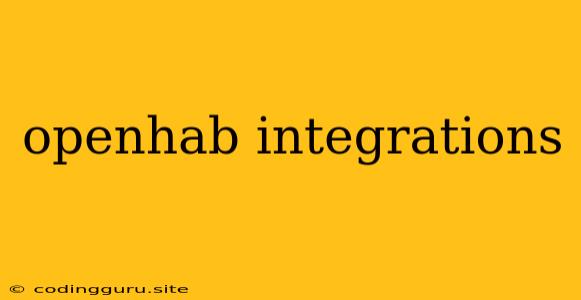OpenHAB Integrations: Connecting Your Smart Home
OpenHAB, the open-source home automation platform, thrives on its extensive integration capabilities. This allows you to connect and control a wide range of devices and services, making your smart home truly intelligent. But with so many options available, how do you choose the right openHAB integrations for your needs?
This guide will delve into the world of openHAB integrations, exploring their benefits, the different types, and how to get started.
What are OpenHAB Integrations?
OpenHAB integrations are essentially bridges that allow your OpenHAB system to communicate with external devices, services, and protocols. They act as translators, enabling OpenHAB to understand and control these external elements. Think of it as building a network of interconnected devices, all managed seamlessly through your OpenHAB hub.
Why Use OpenHAB Integrations?
- Expand Your Smart Home: Integrations let you incorporate new devices into your existing setup, building a comprehensive smart home ecosystem.
- Automate Tasks: By combining different devices and services, you can automate everyday tasks, like turning off lights when leaving home or setting the thermostat based on your location.
- Create Custom Solutions: The flexibility of openHAB integrations allows you to tailor your smart home to your specific needs, even building custom integrations if needed.
- Enhanced Functionality: Integrations can unlock new features and capabilities within your existing devices, adding functionality that wouldn't be possible otherwise.
Types of OpenHAB Integrations
OpenHAB integrations come in various flavors, categorized by their functionality and target devices:
- Device Bindings: These are the most common types of integrations. Bindings connect to specific device brands or protocols, enabling you to control their functionality directly from OpenHAB. Examples include Philips Hue, Sonos, Zigbee, and Z-Wave.
- REST APIs: REST (Representational State Transfer) APIs allow OpenHAB to communicate with web-based services like weather apps, news feeds, or even your own custom applications.
- MQTT: MQTT (Message Queuing Telemetry Transport) is a lightweight messaging protocol often used for IoT devices. OpenHAB integrations for MQTT enable communication with devices that use this protocol, like sensors or actuators.
- Network Services: Integrations like openHAB Cloud Connector provide remote access and control of your OpenHAB system from anywhere.
Getting Started with OpenHAB Integrations
- Explore the OpenHAB Marketplace: Start by exploring the extensive marketplace where you can find a wide array of openHAB integrations. Filter by device brand, protocol, or functionality to find the ones you need.
- Install and Configure: Most openHAB integrations are easily installed via the OpenHAB Add-ons UI. Once installed, you'll need to configure them according to the specific instructions provided.
- Test and Verify: After installation, thoroughly test your openHAB integrations to ensure they are working correctly and integrated with your existing smart home setup.
Examples of OpenHAB Integrations
- Controlling Smart Lights: Integrating a binding like Philips Hue allows you to manage your Hue lights directly from OpenHAB, including dimming, color changing, and setting schedules.
- Home Automation with Weather: Use a REST API integration to fetch real-time weather data and automate actions based on conditions, such as closing blinds on sunny days or turning on heating when it's cold.
- Monitoring Energy Usage: Integrate a MQTT binding to receive data from smart meters, allowing you to track your energy consumption and identify areas for potential savings.
Tips for Successful OpenHAB Integrations
- Start Small: Begin with a few basic integrations and gradually expand your system as you become more familiar with OpenHAB.
- Understand Your Needs: Clearly define your smart home goals and choose integrations that align with your desired functionality.
- Read the Documentation: Carefully review the documentation for each integration to ensure proper configuration and troubleshoot any issues.
- Consider Security: Secure your OpenHAB installation and any connected devices with strong passwords and security best practices.
- Join the Community: Engage with the vibrant OpenHAB community for support, tutorials, and shared knowledge.
Conclusion
OpenHAB integrations are the key to unlocking the true potential of your smart home. By connecting different devices, services, and protocols, you can create a system that seamlessly automates tasks, enhances convenience, and adds value to your daily life. With a little exploration and guidance, you can leverage the power of openHAB integrations to build a smart home that works for you.
